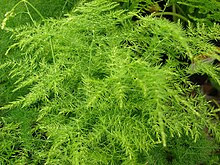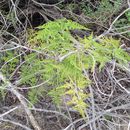Associations
provided by BioImages, the virtual fieldguide, UK
Foodplant / sap sucker
hypophyllous, colonial Aspidioterus nerii sucks sap of live leaf of Asparagus plumosus
Foodplant / sap sucker
Aulacorthum circumflexum sucks sap of live, distorted stem of Asparagus plumosus
Foodplant / sap sucker
Pseudococcus sucks sap of live green part of Asparagus plumosus
Foodplant / sap sucker
Saissetia coffeae sucks sap of live leaf of Asparagus plumosus
Comments
provided by eFloras
The foliage is much used by florists.
- license
- cc-by-nc-sa-3.0
- copyright
- Missouri Botanical Garden, 4344 Shaw Boulevard, St. Louis, MO, 63110 USA
Description
provided by eFloras
Vines, woody, scrambling or climbing to 5 m; roots fibrous. Stems to 4 m, wiry, smooth, branches planate; cladophylls in fascicles of (5–)8–20 per node, filiform, 4–10 × 0.5 mm, ± rigid, with single vein. Leaves membranous, 1–2 mm; blade forming short spine with reflexed apex, base hardened. Inflorescences terminally umbellate, 1–4-flowered. Flowers bisexual, nodding; perianth spreading, campanulate; tepals white, 3–4 × 1–1.5 mm; pedicel 1–3 mm, jointed at or just above base. Berries purplish black, 4–5 mm. Seeds 1–3. 2n = 20.
- license
- cc-by-nc-sa-3.0
- copyright
- Missouri Botanical Garden, 4344 Shaw Boulevard, St. Louis, MO, 63110 USA
Description
provided by eFloras
Herbs hermaphroditic. Stems climbing, much branched, to several meters, slightly woody near base; branches spreading horizontally, with branchlets and cladodes arranged in 1 plane, frondlike. Cladodes in fascicles of 10--13, 4--5 mm, very slender, slightly trigonous. Leaf spur short, occasionally spinescent on main stems. Inflorescences developing after cladodes. Flowers solitary or in clusters of 2 or 3; pedicel short, articulate at middle. Perianth white; segments widely spreading, lanceolate-oblong, ca. 7 mm. Berry purplish black, 6--7 mm in diam., 1--3-seeded. Fl. Jun. 2 n = 20*.
- license
- cc-by-nc-sa-3.0
- copyright
- Missouri Botanical Garden, 4344 Shaw Boulevard, St. Louis, MO, 63110 USA
Distribution
provided by eFloras
introduced; Calif., Fla.; s, e Africa.
- license
- cc-by-nc-sa-3.0
- copyright
- Missouri Botanical Garden, 4344 Shaw Boulevard, St. Louis, MO, 63110 USA
Flowering/Fruiting
provided by eFloras
Flowering spring--summer.
- license
- cc-by-nc-sa-3.0
- copyright
- Missouri Botanical Garden, 4344 Shaw Boulevard, St. Louis, MO, 63110 USA
Habitat
provided by eFloras
Waste places, abandoned gardens; 0--100m.
- license
- cc-by-nc-sa-3.0
- copyright
- Missouri Botanical Garden, 4344 Shaw Boulevard, St. Louis, MO, 63110 USA
Habitat & Distribution
provided by eFloras
Commonly cultivated and occasionally becoming naturalized [native to S Africa].
- license
- cc-by-nc-sa-3.0
- copyright
- Missouri Botanical Garden, 4344 Shaw Boulevard, St. Louis, MO, 63110 USA
Synonym
provided by eFloras
Asparagopsis setacea Kunth, Abh. Königl. Akad. Wiss. Berlin 1842: 82. 1842; Asparagus plumosus Baker
- license
- cc-by-nc-sa-3.0
- copyright
- Missouri Botanical Garden, 4344 Shaw Boulevard, St. Louis, MO, 63110 USA
Synonym
provided by eFloras
Asparagopsis setacea Kunth, Enum. Pl. 5: 82. 1850; Asparagus plumosus Baker.
- license
- cc-by-nc-sa-3.0
- copyright
- Missouri Botanical Garden, 4344 Shaw Boulevard, St. Louis, MO, 63110 USA
Description
provided by Flora of Zimbabwe
Evergreen perennial erect or climbing herb up to 2 m. Stems unarmed except for a few basal spines. Branches spreading with short branchlets densely covered with clusters of numerous short, needle-like cladodes.
- license
- cc-by-nc
- copyright
- Mark Hyde, Bart Wursten and Petra Ballings
- bibliographic citation
- Hyde, M.A., Wursten, B.T. and Ballings, P. (2002-2014). Asparagus setaceus (Kunth) Jessop Flora of Zimbabwe website. Accessed 28 August 2014 at http://www.zimbabweflora.co.zw/speciesdata/species.php?species_id=164460
- author
- Mark Hyde
- author
- Bart Wursten
- author
- Petra Ballings
Asparagus setaceus
provided by wikipedia EN
Asparagus setaceus, commonly known as common asparagus fern, asparagus grass, lace fern, climbing asparagus, or ferny asparagus, is a climbing plant in the genus Asparagus.[2] Despite its common name, the plant is not a true fern, but has leaves that resemble one.[3]
Naming
Originally described by the German botanist Carl Sigismund Kunth, its Latin specific epithet setaceus means "hairy".[4]
Description

Asparagus setaceus foliage.
Asparagus setaceus is a scrambling perennial herb with tough green stems and leaves, which may reach several metres in length. The leaves are actually leaf-like cladodes up to 7 mm long by 0.1 mm in diameter, which arise in clumps of up to 15 from the stem, making a fine, soft green fern-like foliage. Sharp barbed thorns occur on the stem. Occurring from spring to autumn, the small greenish-white bell-shaped flowers are 0.4 cm long, and are followed by small green berries, which blacken with maturity.[5]
Distribution
It is native to Southern Africa, extending south west as far as Calitzdorp in the Karoo.
It is grown elsewhere as an ornamental plant. It has become an invasive species in several locations where it has been introduced.[6]
Cultivation
Asparagus setaceus is cultivated as an ornamental plant, for planting in garden and containers, and as a house plant. The attractive foliage is also used in floral arrangements. It is very hardy and adapts readily to cultivation.
This hardiness has helped it become a weed in Lord Howe and Norfolk Islands.[7] Other areas that regard it as an invasive species and noxious weed include the North Coast of New South Wales,[8] and Queensland, Australia.[9]
This plant has gained the Royal Horticultural Society’s Award of Garden Merit.[10]
The fruit (berries) of this plant are toxic and should not be eaten.
References

- license
- cc-by-sa-3.0
- copyright
- Wikipedia authors and editors
Asparagus setaceus: Brief Summary
provided by wikipedia EN
Asparagus setaceus, commonly known as common asparagus fern, asparagus grass, lace fern, climbing asparagus, or ferny asparagus, is a climbing plant in the genus Asparagus. Despite its common name, the plant is not a true fern, but has leaves that resemble one.
- license
- cc-by-sa-3.0
- copyright
- Wikipedia authors and editors

